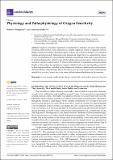Por favor, use este identificador para citar o enlazar a este item:
http://hdl.handle.net/10261/249390COMPARTIR / EXPORTAR:
 SHARE SHARE
 CORE
BASE CORE
BASE
|
|
| Visualizar otros formatos: MARC | Dublin Core | RDF | ORE | MODS | METS | DIDL | DATACITE | |

| Campo DC | Valor | Lengua/Idioma |
|---|---|---|
| dc.contributor.author | FitzGerald, J. A. | es_ES |
| dc.contributor.author | Rocher, Asunción | es_ES |
| dc.date.accessioned | 2021-09-03T09:20:17Z | - |
| dc.date.available | 2021-09-03T09:20:17Z | - |
| dc.date.issued | 2021-07-12 | - |
| dc.identifier.citation | Antioxidants 10(7): 1114 (2021) | es_ES |
| dc.identifier.uri | http://hdl.handle.net/10261/249390 | - |
| dc.description | © 2021 by the authors | es_ES |
| dc.description.abstract | Oxygen is an essential requirement for metabolism in mammals and many other animals. Therefore, pathways that sense a reduction in available oxygen are critical for organism survival. Higher mammals developed specialized organs to detect and respond to changes in O<sub>2</sub> content to maintain gas homeostasis by balancing oxygen demand and supply. Here, we summarize the various oxygen sensors that have been identified in mammals (carotid body, aortic bodies, and astrocytes), by what mechanisms they detect oxygen and the cellular and molecular aspects of their function on control of respiratory and circulatory O<sub>2</sub> transport that contribute to maintaining normal physiology. Finally, we discuss how dysregulation of oxygen availability leads to elevated signalling sensitivity in these systems and may contribute to the pathogenesis of chronic cardiovascular and respiratory diseases and many other disorders. Hence, too little oxygen, too much oxygen, and a malfunctioning sensitivity of receptors/sensors can create major pathophysiological problems for the organism. | es_ES |
| dc.description.sponsorship | Grant reference BFU2015-70616-R (MINECO/FEDER; DGICYT), and VA106G18 (JCyL), Spain | es_ES |
| dc.language.iso | eng | es_ES |
| dc.publisher | Multidisciplinary Digital Publishing Institute | es_ES |
| dc.relation | info:eu-repo/grantAgreement/MINECO//BFU2015-70616-R/ES/IMPLICACIONES FISIOPATOLOGICAS DE LA APNEA OBSTRUCTIVA DEL SUEÑO: HIPERTENSION ARTERIAL Y TUMOROGENESIS/ | es_ES |
| dc.rights | openAccess | es_ES |
| dc.subject | Oxygen sensing | es_ES |
| dc.subject | Cardiovascular disease | es_ES |
| dc.subject | Carotid body | es_ES |
| dc.subject | Aortic bodies | es_ES |
| dc.subject | Astrocytes | es_ES |
| dc.subject | Hypoxia | es_ES |
| dc.title | Physiology and Pathophysiology of Oxygen Sensitivity | es_ES |
| dc.type | artículo | es_ES |
| dc.identifier.doi | 10.3390/antiox10071114 | - |
| dc.description.peerreviewed | Peer reviewed | es_ES |
| dc.identifier.e-issn | 2076-3921 | - |
| dc.date.updated | 2021-09-03T09:20:17Z | - |
| dc.contributor.funder | Ministerio de Economía y Competitividad (España) | es_ES |
| dc.contributor.funder | Junta de Castilla y León | es_ES |
| dc.relation.csic | Sí | es_ES |
| dc.identifier.funder | http://dx.doi.org/10.13039/501100014180 | es_ES |
| dc.identifier.funder | http://dx.doi.org/10.13039/501100003329 | es_ES |
| dc.identifier.pmid | 34356347 | - |
| dc.type.coar | http://purl.org/coar/resource_type/c_6501 | es_ES |
| item.grantfulltext | open | - |
| item.fulltext | With Fulltext | - |
| item.openairecristype | http://purl.org/coar/resource_type/c_18cf | - |
| item.languageiso639-1 | en | - |
| item.cerifentitytype | Publications | - |
| item.openairetype | artículo | - |
| Aparece en las colecciones: | (IBGM) Artículos | |
Ficheros en este ítem:
| Fichero | Descripción | Tamaño | Formato | |
|---|---|---|---|---|
| Physiology and Pathophysiology_Ftizgerald_PV_Art2021.pdf | 367,02 kB | Adobe PDF |  Visualizar/Abrir |
CORE Recommender
PubMed Central
Citations
3
checked on 21-may-2024
SCOPUSTM
Citations
3
checked on 16-may-2024
WEB OF SCIENCETM
Citations
4
checked on 26-feb-2024
Page view(s)
49
checked on 22-may-2024
Download(s)
112
checked on 22-may-2024
Google ScholarTM
Check
Altmetric
Altmetric
Artículos relacionados:
NOTA: Los ítems de Digital.CSIC están protegidos por copyright, con todos los derechos reservados, a menos que se indique lo contrario.
